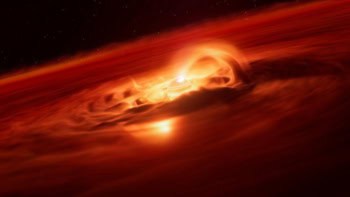The tails of comets are millions of miles longer than previously thought. The discovery was made by two teams of astronomers who were trying to understand why an instrument on the Ulysses spacecraft - which is studying the solar wind - suddenly went haywire for a few hours in May 1996. They later discovered that two instruments on Ulysses - the solar wind ion composition spectrometer (SWICS) and a magnetometer - were actually measuring the tail of Comet Hyakutake some 500 million kilometres away from the comet's nucleus. The length of the comet's tail was therefore twice that of the previous record holder - the 'Great March Comet' of 1843. The technique may allow other previously 'hidden' comets to be detected (Nature 404 574 and 576).
Ulysses was launched to make continuous measurements of the solar wind, a steady stream of ionized particles that flows outwards from the star. In 1998 Pete Riley and colleagues from Los Alamos National Laboratory published a paper describing a dramatic drop in the number of protons registered by Ulysses. They suggested that a comet could have caused the signal.
Recently two groups independently discovered that Comet Hyakutake was probably the source of the signal. Geraint Jones of Imperial College in London and colleagues used the magnetometer to calculate the size of the comet’s tail. “The fast, polar solar wind preserved the structure of the tail over an exceptional distance,” says Jones, “otherwise it would have been extremely hard to recognize it.” Jones noticed that Comet Hyakutake had crossed between the Sun and Ulysses on the 23 April 1996, which was 8 days before the instruments went haywire on 1 May. The size of the tail, together with its magnetic field, speed and the position of the spacecraft, pointed to Hyakutake as the source.
Meanwhile, a team led by George Gloeckler from the University of Maryland noticed that the SWICS detector on Ulysses had picked up the same patterns of carbon, nitrogen and oxygen ions detected in Halley’s comet. After hearing about the magnetic field results from Jones, they concluded that the ions were from Hyakutake. “We were greatly surprised to find cometary material so far away from the nucleus,” he says, “and the discovery of otherwise invisible comets may [now] be possible.”
However, Jones does not intend to spend too much time looking for comets. “The chances are really small that a comet’s tail will pass in front of Ulysses,” he says, “but we may well be surprised again.”



